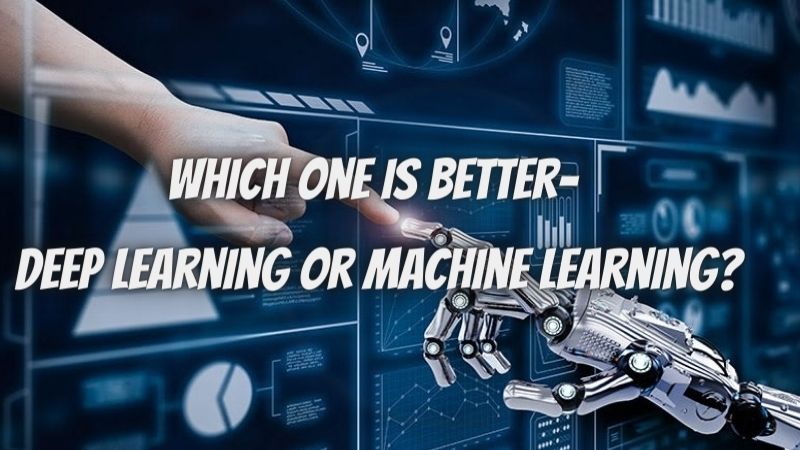Artificial Intelligence enables machines to learn from their experiences and adapt to various inputs in order to execute tasks that humans can do. Artificial Intelligence, Machine Learning and Deep Learning are interrelated concepts. While machine learning is a subset of artificial intelligence, deep learning is a subset of machine learning. This can be better understood by the following venn diagram-
As the significance of data is increasing, the demand for data scientists is also rising, and is necessitating their assistance in identifying the most relevant business questions and, as a result, the data needed to answer them.
In this article, we will discuss Machine Learning and Deep Learning.
Machine Learning
Machine learning is a subset of artificial intelligence that involves using statistical methodologies to facilitate the development of algorithms which help in making classifications and predictions related to data and, as a result, makes a significant contribution to the field of data science.
Businesses and organisations can make faster decisions and speed up their workflow with the help of machine learning courses.
Machine learning generally involves two techniques, unsupervised learning and supervised learning.
- Unsupervised Learning – In unsupervised machine learning technique, the algorithm is given a data set which does not have any previous classification, i.e., it includes unlabelled data. It is well suited for clustering and association, and facilitates pattern/ structure discovery.
- Supervised Learning- In supervised learning, an example data set is provided to the algorithm and data is already divided into categories or clusters, i.e., it includes labelled data. It is well suited for classification and regression, and facilitates working of predictive models.
In semi-supervised machine learning, the algorithm is trained using both labelled and unlabeled data. Reinforcement learning algorithms are a set of algorithms for determining the optimum actions to be done in a particular situation in order to maximise overall reward.
Advantages of Machine Learning
Some of the advantages of machine learning include-
- Automation- Machine learning’s ability to automate numerous decision-making activities saves developers a lot of time, effort, and money, allowing them to focus on other important tasks.
- Improvement over time- Machine learning can learn from the data that is given to it. With each new set of data added, the model’s efficiency and accuracy in making decisions improves.
- Wide range of applications- Machine learning is now used in almost every area, including defence, healthcare, education, financial institutions, businesses and e-commerce to name a few. Increases profit, reduces costs, processes are automated, trends and patterns from historical data are analysed, and many more.
Deep Learning
Deep learning is a subset of machine learning that entails the use of neural networks with several layers of processing to extract higher-level features from data sets. Its fundamental goal is to imitate human-like decision making. Just as neurons in the human brain pass signals to allow actions to be performed, artificial neurons in a neural network help in execution of tasks like clustering, classification, and regression.
Processes involved in deep learning require systems with powerful hardware as it deals with a large amount of data that involves several complex numerical calculations.
- Functioning includes sending signals between nodes and assigning weights to them.
- A node with a higher weight will have a greater impact on the nodes underneath it.
- The last layer assembles the weighted inputs into a result.
Advantages of Deep Learning
- Features are deduced automatically and efficiently for obtaining the desired outcomes.
- When it comes to data science activities, deep learning yields actionable results.
- Similar approach of neural networks can be used for different types of data sets and applications.
- A deep learning system can undertake thousands of repetitive and routine tasks in less time than what it would take a human to complete them.
Machine Learning vs Deep Learning
Deep learning requires big data sets for training, whereas machine learning can train with less data. Deep learning requires higher performance hardware as compared to machine learning.
Decision trees and other machine learning algorithms provide us with clear criteria for why it chose what it did, making the reasoning behind it particularly simple to understand. As compared to machine learning, tasks in deep learning take considerably longer time for getting trained. PG courses in Machine Learning will help you learn skills that make you job ready.
Deep learning has a number of advantages over traditional machine learning algorithms, one of which is its ability to perform feature engineering on its own. A deep learning algorithm’s neural networks can identify new, more complicated features that humans would probably miss. Unstructured data is difficult for most machine learning algorithms to evaluate, which means it is underutilised. Deep Learning may be a better option in this context. Deep learning offers an end-to-end solution to a problem whereas, in machine learning tasks are required to be divided into parts to obtain the combined effect.
FAQs
What is implied by reinforcement learning in machine learning?
The training of machine learning models to make a series of judgments is known as reinforcement learning. In an uncertain, potentially complicated environment the agent learns to achieve a goal, i.e., it learn from the consequences of its actions in a given environment.
What are the limitations of deep learning?
- General intelligence and cross-domain integration are lacking.
- Deep Learning is devoid of logic. As a result, the systems are fragile, and when errors occur, the consequences can be severe.




